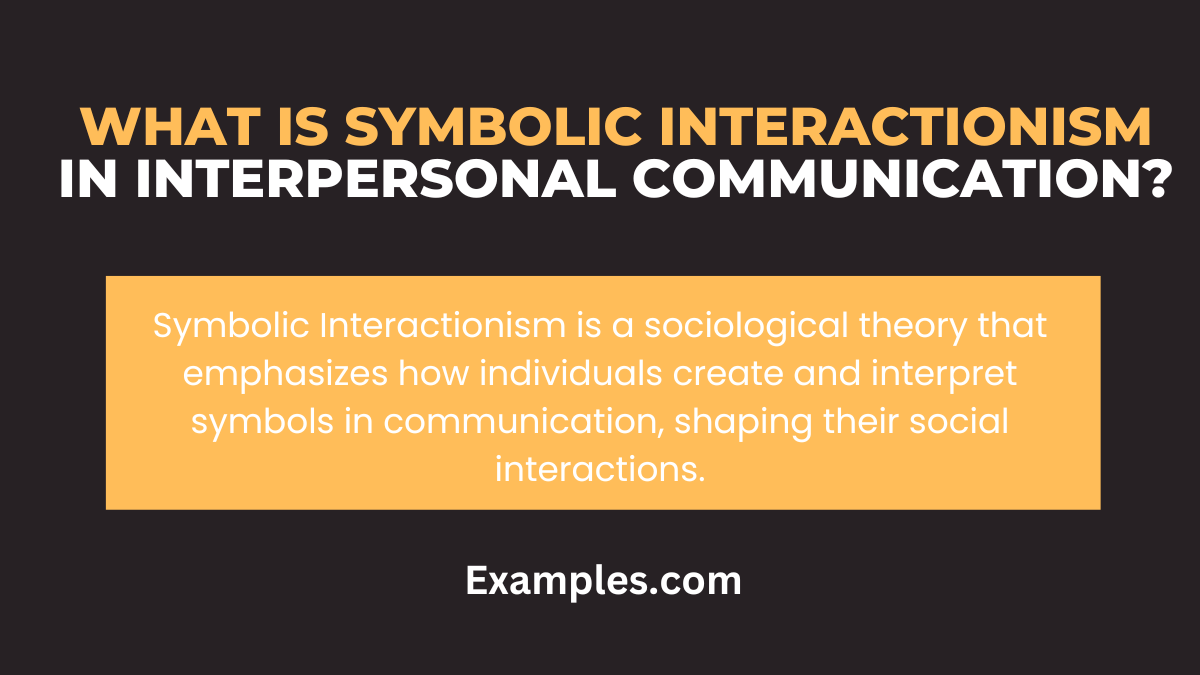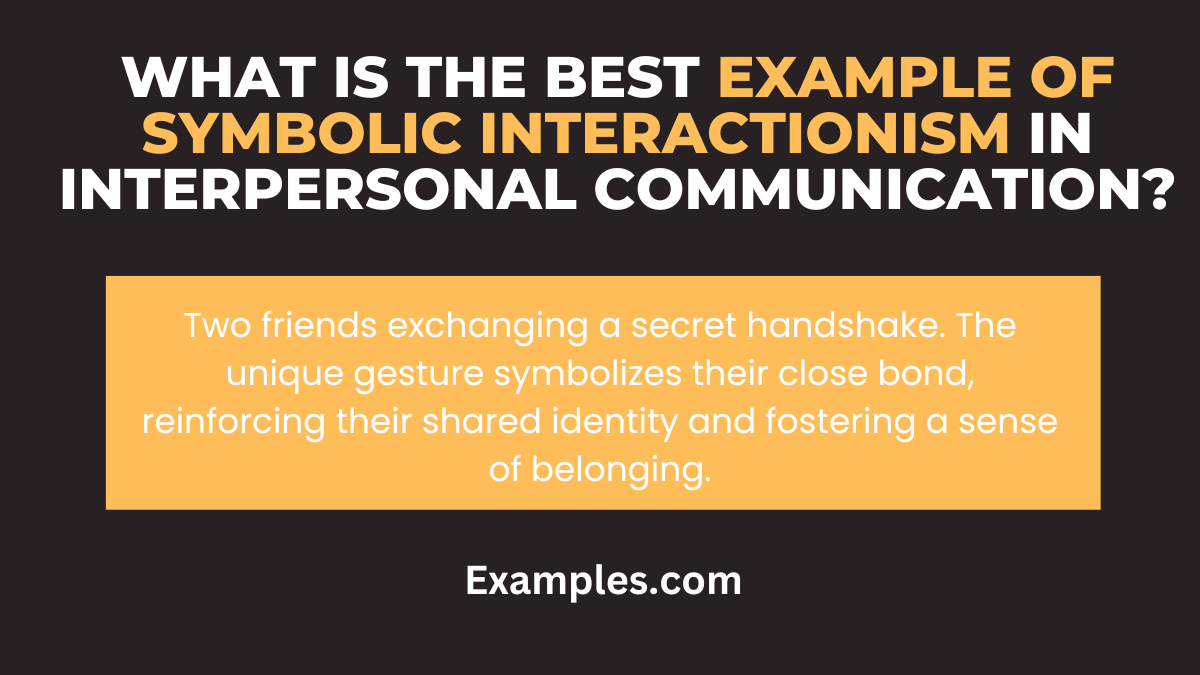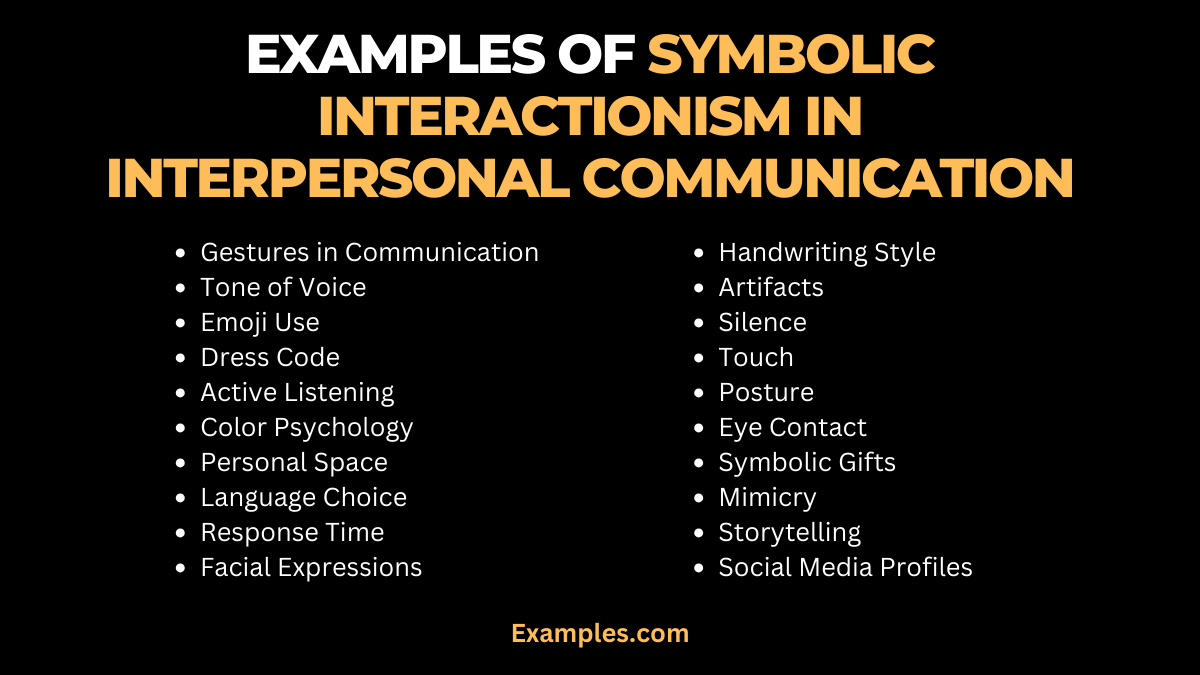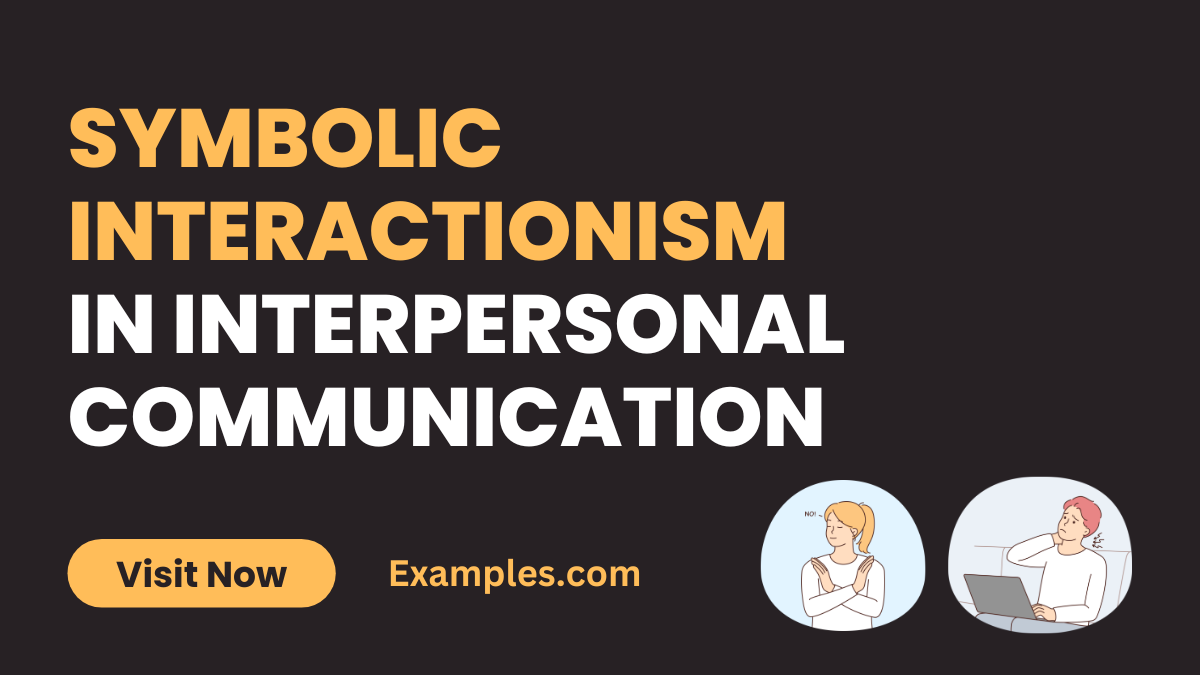19+ Symbolic Interactionism in Interpersonal Communication Examples
Interpersonal Communication is a multifaceted concept that evolves with every interaction. At its core, Symbolic Interactionism plays a pivotal role, shaping how we perceive and engage with others. This approach highlights the significance of symbols and language in our daily interactions, offering profound insights into the dynamics of communication. Understanding Symbolic Interactionism opens a window to more effective and empathetic communication, enhancing our ability to connect and share experiences in a meaningful way.
What is Symbolic Interactionism in Interpersonal Communication?

Symbolic Interactionism, a key concept in Interpersonal Communication, revolves around the idea that our interactions are largely influenced by the symbols and meanings we ascribe to them. It suggests that our perceptions and behaviors are shaped by the symbolic meaning we derive from language, gestures, and actions in social contexts. This approach underscores the power of shared meanings and how they mold our communication patterns.
History
Who Created: George Herbert Mead
Date: 20th century
This theory emerged from the broader field of social psychology, emphasizing how human beings interpret and respond to symbolic cues in their environment. Its historical roots lie in understanding how individuals construct their social reality through language and symbols, which remains a cornerstone in exploring various facets of interpersonal communication.
What is the Best Example of Symbolic Interactionism in Interpersonal Communication?

One of the best examples of Symbolic Interactionism in Interpersonal Communication is the use of gestures in a conversation. For instance, a thumbs-up in many cultures symbolizes approval or agreement. This simple gesture, laden with societal meaning, can communicate a message without the need for words, showcasing how non-verbal cues play a critical role in conveying ideas and emotions in interpersonal interactions.
20 Examples of Symbolic Interactionism in Interpersonal Communication

Symbolic interactionism plays a pivotal role in Interpersonal Communication. This sociological perspective illuminates how people use symbols and meanings to navigate and give context to their social interactions. Understanding this concept is crucial in diverse communication forms like verbal, non-verbal, and digital communication. Here are 20 examples showcasing symbolic interactionism’s impact on interpersonal communication, complete with brief explanations and practical communication sentences.
- Gestures in Non-Verbal Communication: Using hand gestures to emphasize a point.
Example: Nodding to signify agreement during a conversation. - Tone of Voice in Verbal Communication: Changing tone to convey different emotions.
Example: Speaking softly to show empathy. - Emoji Use in Digital Communication: Using emojis to express feelings in texts.
Example: Sending a heart emoji to show affection. - Dress Code in Visual Communication: Wearing specific attire to convey professionalism.
Example: Dressing formally for a job interview to imply seriousness. - Active Listening in Interpersonal Communication: Nodding and making eye contact to show engagement.
Example: “I see what you mean,” while maintaining eye contact. - Color Psychology in Visual Communication: Using colors to evoke certain emotions.
Example: Wearing red to convey passion or power. - Personal Space in Non-Verbal Communication: Adjusting proximity to reflect intimacy or boundaries.
Example: Standing closer to a friend than to a colleague. - Language Choice in Verbal Communication: Using formal or informal language based on the relationship.
Example: Using slang with friends but not in a professional meeting. - Response Time in Digital Communication: The time taken to reply to a message indicating interest or disinterest.
Example: Replying quickly to show eagerness. - Facial Expressions in Emotional Expression: Smiling or frowning to convey happiness or displeasure.
Example: Smiling to show you’re pleased with someone’s news. - Handwriting Style in Written Communication: The neatness or sloppiness of handwriting imparting a message.
Example: Writing neatly in a thank-you note to show effort and care. - Artifacts in Visual Communication: Using objects to symbolize personal or cultural identity.
Example: Wearing a religious symbol to signify faith. - Silence in Verbal Communication: Using pauses or silence to convey meaning or emotion.
Example: Pausing before responding to emphasize thoughtfulness. - Touch in Non-Verbal Communication: Using touch to show support or sympathy.
Example: A comforting pat on the back. - Posture in Non-Verbal Communication: Standing or sitting posture indicating openness or defensiveness.
Example: Leaning forward to show interest. - Eye Contact in Listening: Maintaining or avoiding eye contact to show interest or discomfort.
Example: Maintaining steady eye contact to show you’re paying attention. - Symbolic Gifts in Emotional Expression: Giving gifts that have a special meaning.
Example: Giving a book you love to a friend to share part of yourself. - Mimicry in Small Group Communication: Copying someone’s behavior or speech patterns to build rapport.
Example: Mirroring a friend’s body language during a conversation. - Storytelling in Public Communication: Using stories to connect with audiences on a personal level.
Example: Sharing a personal anecdote during a speech. - Social Media Profiles in Digital Communication: Curating profiles to project a desired image or identity.
Example: Posting certain types of photos on Instagram to convey a particular lifestyle.
Principles of Symbolic Interactionism in Interpersonal Communication
Symbolic interactionism, a significant theory in Interpersonal Communication, plays a crucial role in understanding how individuals interact and interpret various symbols in social interactions. Here are seven key principles:
- Human Interaction through Symbols: This theory posits that people communicate through the use of symbols, such as words, gestures, and images, which are imbued with meaning.
- Meaning Construction: Meanings are not inherent in symbols but are created through interaction. Individuals develop and modify these meanings in their social context.
- Active Role of the Individual: People are not passive recipients of societal symbols. They actively interpret and decide what these symbols mean to them.
- Social Reality Shaping: Through symbolic interaction, individuals contribute to the shaping of their social reality, influencing norms, behaviors, and social roles.
- Role Taking: This principle emphasizes the ability of individuals to put themselves in others’ shoes, understanding their perspectives, which is vital in effective communication.
- Dynamic Nature of Communication: Symbolic interactionism highlights that communication is dynamic and constantly evolving as individuals interact and negotiate meanings.
- Influence on Self-Concept: The theory suggests that through interaction, individuals form an image of themselves based on how others perceive and respond to them.
How did Symbolic Interactionism Help in Interpersonal Communication?
Symbolic interactionism aids in understanding and enhancing interpersonal communication in several ways:
- Improves Empathy: By understanding that people assign different meanings to symbols, individuals learn to empathize and respect diverse perspectives.
- Enhances Self-awareness: It encourages individuals to reflect on how their communication affects their self-identity and relationships.
- Promotes Effective Communication: Recognizing the significance of symbols helps in choosing words and actions more thoughtfully, improving clarity and understanding.
- Facilitates Conflict Resolution: Understanding the subjective nature of meanings can aid in resolving misunderstandings and conflicts.
- Strengthens Relationships: By appreciating the role of symbolic interaction in shaping relationships, individuals can develop deeper connections.
- Aids in Adaptability: This theory teaches adaptability in communication, essential in diverse social settings.
- Encourages Active Listening: It highlights the importance of active listening in interpreting and understanding the symbolic meanings conveyed by others.
Formation of Symbolic Interactionism in Interpersonal Communication
The formation of symbolic interactionism in Interpersonal Communication can be traced through these points:
- Roots in Pragmatism: Emerging from the pragmatic philosophy, symbolic interactionism focuses on the practical aspect of human interaction and meaning-making.
- George Herbert Mead’s Influence: Mead’s work laid the foundation for this theory, emphasizing the role of society in the development of the individual.
- Role of Language: Language is seen as the primary symbol system through which meaning is conveyed and understood in interpersonal interactions.
- Evolution through Social Interactions: This theory evolved to highlight how social interactions continuously shape and reshape the meanings of symbols.
- Incorporation of Societal Influence: It acknowledges how societal norms and cultures influence the creation and interpretation of symbols in communication.
- Integration with Other Communication Theories: Over time, symbolic interactionism has been integrated with other communication theories to provide a comprehensive understanding of interpersonal dynamics.
- Adaptation to Digital Age: The theory has adapted to include digital communication, recognizing the evolving nature of symbols and interactions in the digital era.
In conclusion, Symbolic Interactionism in interpersonal communication underscores the profound impact of symbols and language on human interactions. It highlights how our social reality is constructed through the meanings we assign to symbols, a concept critical in understanding Types of Interpersonal Communication. This theory elucidates the dynamic nature of communication, showing that through verbal and non-verbal cues, individuals constantly negotiate their relationships and societal roles. Embracing this framework empowers us to appreciate the subtleties and complexities inherent in every interaction, enhancing our interpersonal communication skills significantly.



